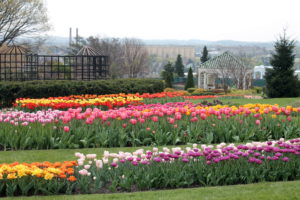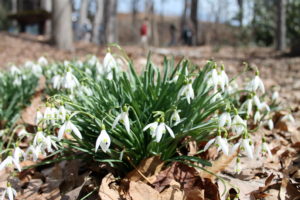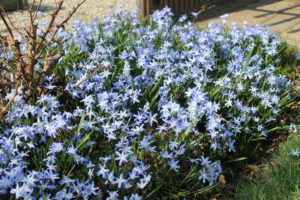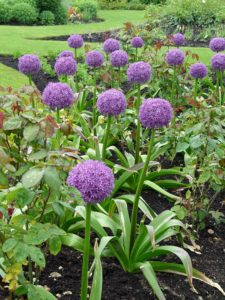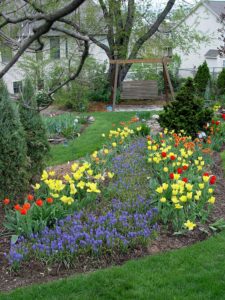Are You Under-Bulbed?
October 3rd, 2017
As a category, I’d have to vote spring-blooming bulbs as the most under-used plant in a typical central-Pa. landscape.
Bulbs can make a glorious spring display – especially when massed as you can see in such public gardens as Hershey and Longwood.
They also have the good-sense timing to bloom when we can appreciate them the most, i.e. after the end of a long, cold, bare winter.
The one problem is that spring bulbs lack the good “marketing sense” to do something interesting right away. You have to plan ahead, plant them in fall, then tolerate nothingness for months until you get your reward.
None of those are strong traits of impatient Americans. We much prefer instant return.
So even though daffodils, hyacinths, Siberian squill and such are colorful, easy to grow and relatively cheap, bulbs aren’t nearly as deployed as they should be.
If you can get past the patience issue, October is the prime month of the year to add bulbs to the landscape.
You’ll have lots of options because bulbs also are very versatile plants. Here are 10 specific bulb-planting possibilities:
If you have shade: Most of the small-flowered, early-emerging bulbs do fine with even with a few hours of sunlight.
Two of the best are Siberian squill (Scilla siberica), early-April bloomers with hanging, blue, bell-shaped flowers on 4-inch plants, and striped squill (Puschkinia scilloides var. libanotica), late-April bloomers with blue-streaked white flowers on 8- to 10-inch plants.
Early risers like those absorb sunlight to recharge themselves before the overhead trees leaf out.
Spanish bluebells (Hyacinthoides hispanica) also tolerate life under trees, even though they don’t send up their blue flower spikes until May.
If you have a wet spot: Most bulbs rot in soggy soil, but a few species tolerate wet soil.
Try summer snowflakes (Leucojum aestivum), which get white, bell-shaped flowers in April to early May; snake’s head fritillaria (Fritillaria meleagris), a foot-tall plant with nodding, checkered, burgundy-purple flowers, and quamash (Camassia esculenta), one of the few native American bulbs, which produce spikes of purplish-blue flowers in late April to early May.
An alternative: add enough soil and compost to build raised beds that lift less wet-tolerant types out of the sogginess.
If you have animal troubles: Rabbits and rodents mainly like tulips and most crocuses.
Hardly anything messes with the daffodil (Narcissus), that familiar cupped flower that comes in a variety of sizes, bloom times and colors (gold, yellow, white and peachy pastels).
Also try anything in the onion (Allium) or fritillaria families.
Lay a sheet of chicken wire over the bed and under the mulch if you’re dead set on growing tulips in rodent country. The bulb shoots will poke up through the openings.
If you want fragrance: Dutch hyacinths (Hyacinthus orientalis) are more fragrant than almost any other flower of any type.
These perfumed beauties are foot-tall, April-bloomers that get fat flower spikes of purple, blue, white, pink or pale yellow.
If you have no yard: Try tulips in a pot, especially shorter types. Plant so that the bulbs are nearly touching in a pot that you can let sit outside all winter (i.e. not breakable terra-cotta or ceramic).
If you’re setting the pot under a porch, water occasionally during above-freezing spells to keep the soil mildly damp. Ditto for pots out in the open if rain or melting snow isn’t doing the deed.
You can even “layer” the planting by inserting tulips 4 to 6 inches deep and then smaller grape hyacinths 2 inches deep. Those two overlap bloom times and will give a full look to the pot.
Growing in pots also discourages rodent digging, but you can eliminate any threat from squirrels, voles, mice and such by stretching a sheet of chicken wire over top of the pot.
If you want something even before spring: Snowdrops (Galanthus nivalis) look like tiny dripping snowballs with their hanging white flowers. They also pop up in late winter – usually the first plant to show new life.
Some years you’ll even find them blooming as a late-January or February snow melts.
Another option is winter aconite (Eranthis hyemalis), which is a mat-growing, late-winter bloomer with buttercup-like yellow flowers that typically spreads by seeding.
If you want a mass of color: Several smaller bulbs are good at colonizing into short carpets of color, which make nice early-spring displays under trees or in beds where you plan to plant annual flowers in May. (Just plant the young annuals right on top of or among the bulbs, or re-insert any that you dig up while planting.)
Glory-of-the-snow (Chionodoxa forbesii) is an April-blooming bulb with star-shaped flowers of blue or pink that makes one of the best spring carpets. Siberian squill and crocus are two other good choices.
If you have kids: Three big-flowered alliums are some of the best Dr. Seuss-like plants that will impress anyone under age 6 (and most people above age 6, for that matter).
Allium ‘Globemaster’ gets softball-sized, round, purple flowers atop 3-top stalks in May to early June, while Allium schubertii and Allium christophii have similar-sized flower heads that look like exploding purple planets.
Crown imperial (Fritillaria imperialis) is another tall oddball with imposing May-blooming, red, gold or orange flowers that form a “crown” of hanging blooms around a strappy green “hairpiece.”
If you want indoor color: Most bulbs can be “tricked” into blooming inside over winter by a process called “forcing.”
Pot the bulbs in fall, then either bury them outside in a leaf-lined pit or store them at just above-freezing temperatures for about three months. In mid-winter, bring the pots inside and watch the warmth cause shoots to emerge a few weeks later while the snow is still flying outside.
Some of the best bulbs for forcing are compact tulips and daffodils, grape hyacinths, Iris reticulata, Dutch hyacinths, crocus and Siberian squill.
Read more in a PennLive garden column I wrote on forcing bulbs.
If you have a boring house front: Dress up your boxed-off green yews and later-blooming azalea balls by planting a 1- to 2-foot-wide band of bright bulbs in front of them.
That’ll give you a few weeks of color in April – and maybe much longer if you plant several kinds of bulbs with varying bloom times instead of all of one thing.
Bulbs look best in bands or clusters as opposed to being lined up single file. And lots of them give far more front-yard impact than a pair of tulip 6-packs.
Good choices include daffodils, compact tulips, and especially near doors and walks, Dutch hyacinths to take advantage of their fragrance.








